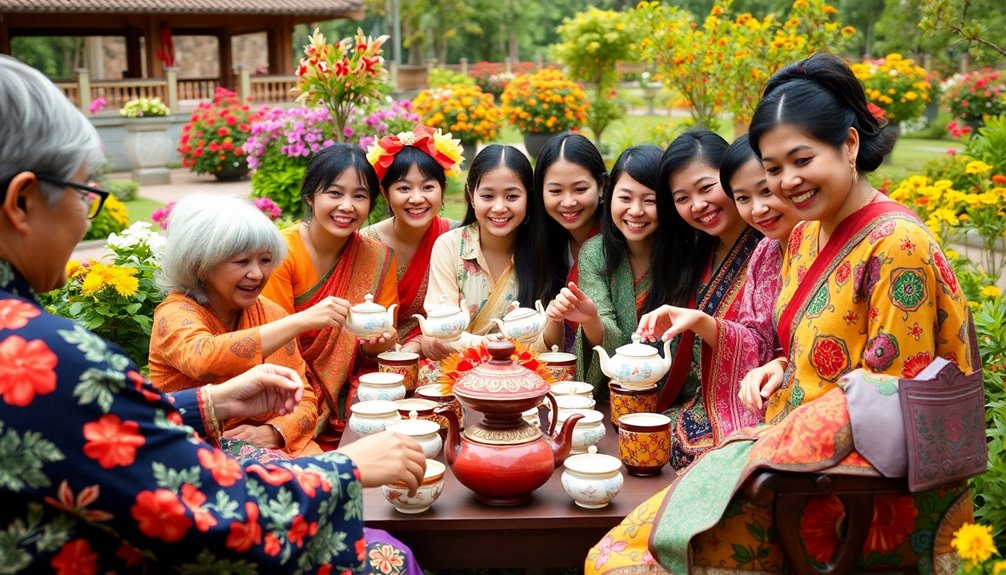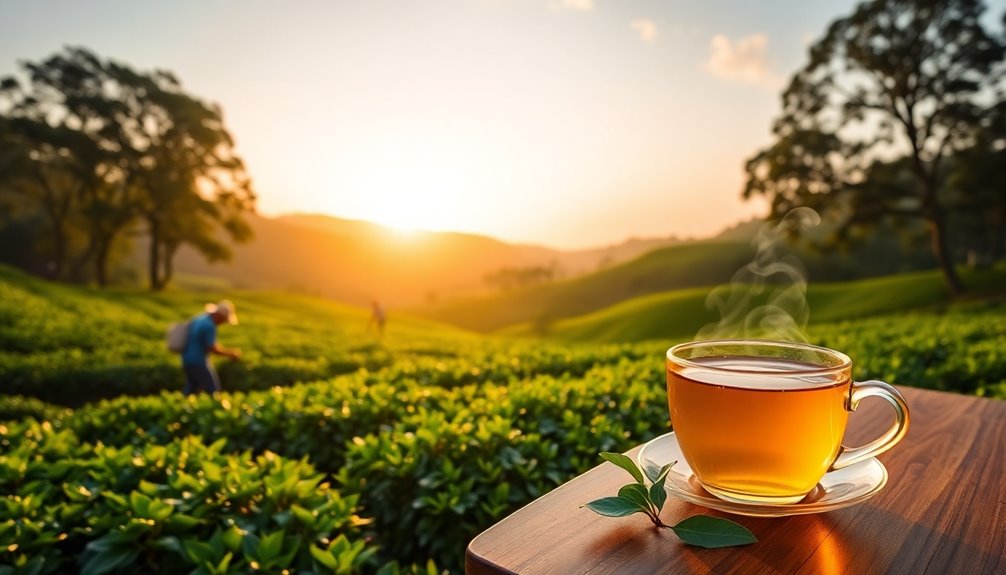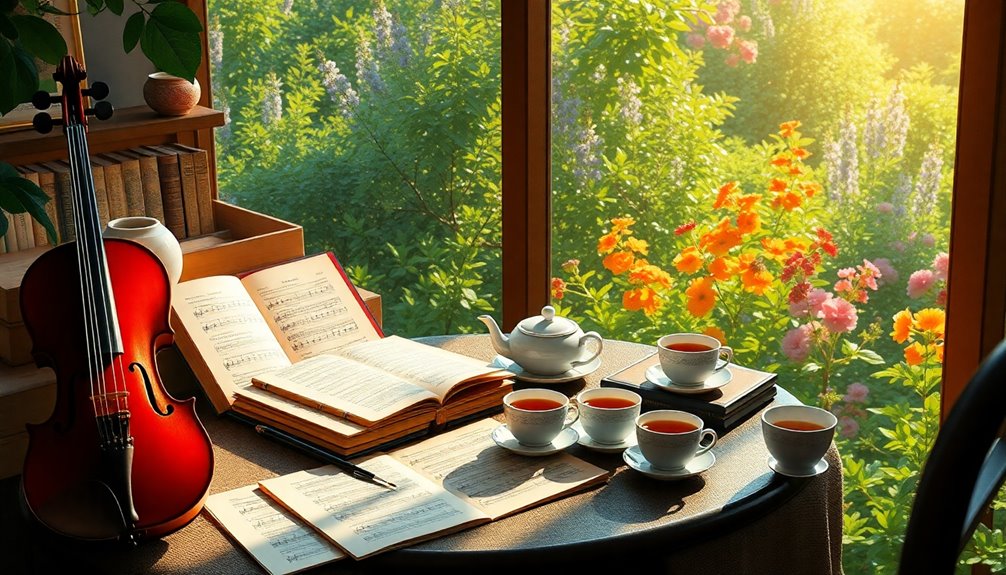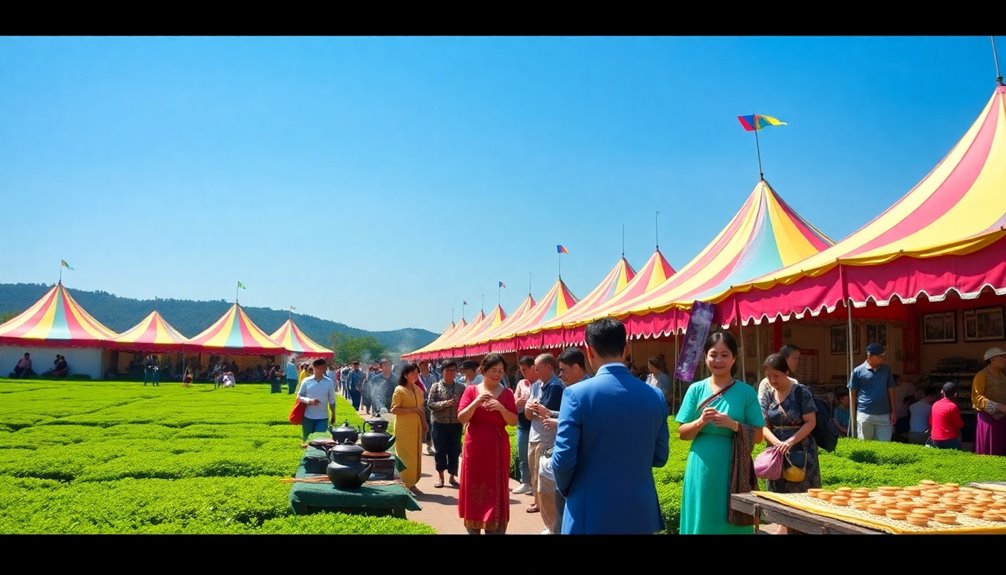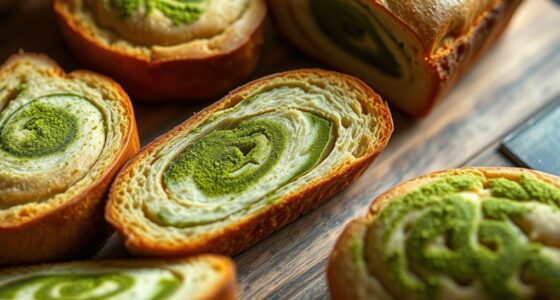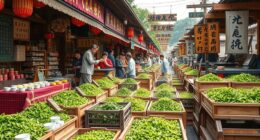Tea's a magical beverage that brings people together in many cultures. From the Chinese Gongfu ceremony to British afternoon tea, sharing tea encourages bonding and conversation. In Morocco and Turkey, tea houses serve as friendly meeting spots where diverse folks connect. Plus, sharing tea can ease tensions, helping with conflict resolution. You can even create your own tea gatherings at home, making stories and friendships flow. It's exciting how tea enriches social lives! If you're curious about the traditions and practices surrounding tea, there's even more fascinating information to explore.
Key Takeaways
- Tea rituals, like the Chinese Gongfu and Japanese Chanoyu, promote harmony and respect, deepening social connections among participants.
- British tea time acts as a community engagement anchor, reinforcing bonds among friends and family through shared experiences.
- Tea houses in Morocco and Turkey serve as social hubs, fostering connections and conversations among diverse backgrounds.
- Sharing tea creates a calm atmosphere conducive to open dialogue, aiding conflict resolution and building trust in various cultures.
- Hosting tea gatherings, whether in-person or virtual, allows individuals to share stories and experiences, strengthening community ties across distances.
Introduction
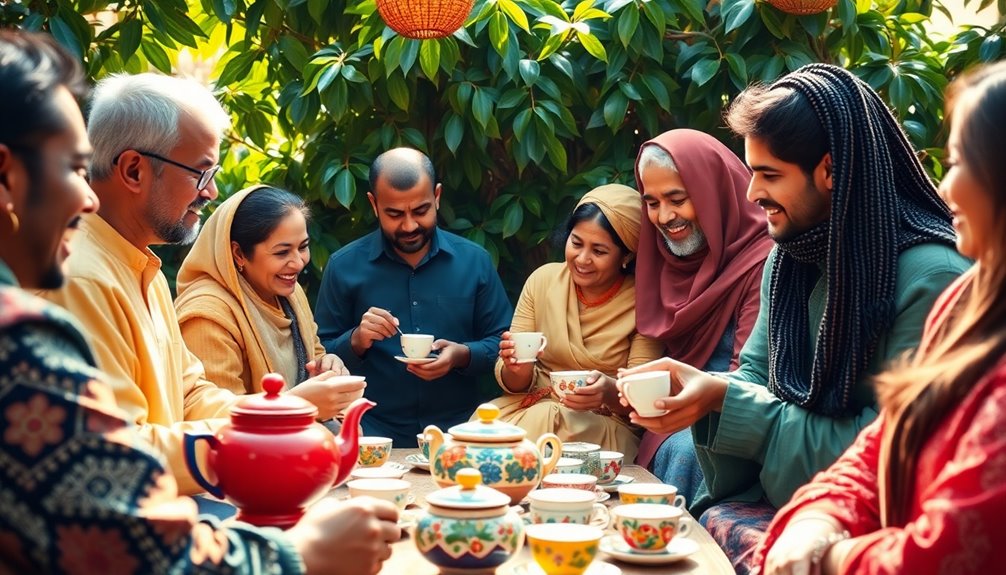
So, whether you're sipping a cup at home or participating in a vibrant tea ceremony, remember that sharing tea is more than just a drink;
it's a celebration of cultural values and a way to foster connections that last a lifetime!
Tea's Historical Trade Routes
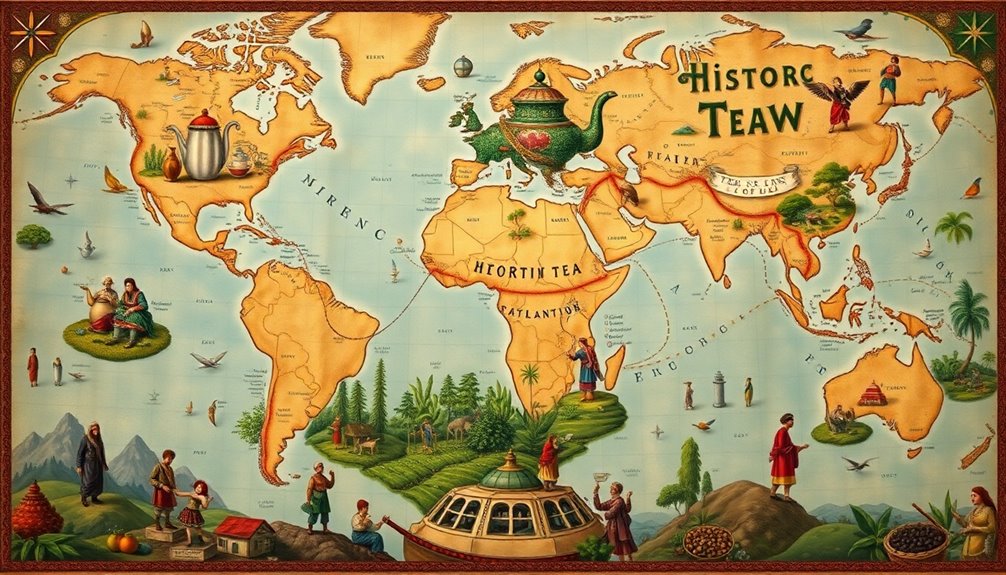
As you explore the rich tapestry of tea culture, it's fascinating to consider how historical trade routes shaped its journey across the globe. The ancient Tea Horse Road was crucial, bringing tea from China to Tibet and creating stronger cultural bonds among people through shared enjoyment.
Similarly, the maritime Silk Road opened up exciting avenues during the Tang and Song dynasties, spreading tea culture to Southeast Asia, the Middle East, and Europe.
In the 17th century, the Dutch led the way as the first European nation to import tea from China. This sparked a tea craze in Europe, paving the way for British tea culture. The East India Company then took charge, monopolizing tea imports to Britain and influencing social practices like afternoon tea—a delightful cultural ritual where people gather together.
These tea trade routes didn't just boost economies; they fostered cross-cultural interactions, turning tea into a true cultural phenomenon.
Whether enjoyed in a cozy home or shared as a sign of hospitality, tea became a medium for social bonding, connecting people and traditions across continents. Isn't it amazing how a simple cup of tea can bring us all together?
Cultural Rituals Enhance Social Bonds

Cultural rituals surrounding tea often play a vital role in enhancing social bonds among individuals.
Whether it's a Chinese Gongfu tea ceremony or Japan's Chanoyu, these traditions emphasize harmony and respect, creating deep connections among participants. When you take part in the act of sharing tea, you're not just enjoying a drink; you're engaging in a ritual that promotes hospitality and open conversation.
In daily life, British tea time serves as a beloved anchor for community engagement. It's a time when friends and family come together to share experiences, reinforcing social bonds.
Similarly, tea houses in Morocco and Turkey act as social hubs, where people from diverse backgrounds gather to chat and connect.
In South Asian culture, serving chai to guests is a symbol of hospitality. This simple act creates opportunities for open conversations, especially during family gatherings or at busy market stalls.
These rituals, from tea ceremonies to daily chai, beautifully illustrate how tea culture strengthens community ties and enhances friendships.
Tea's Role in Conflict Resolution
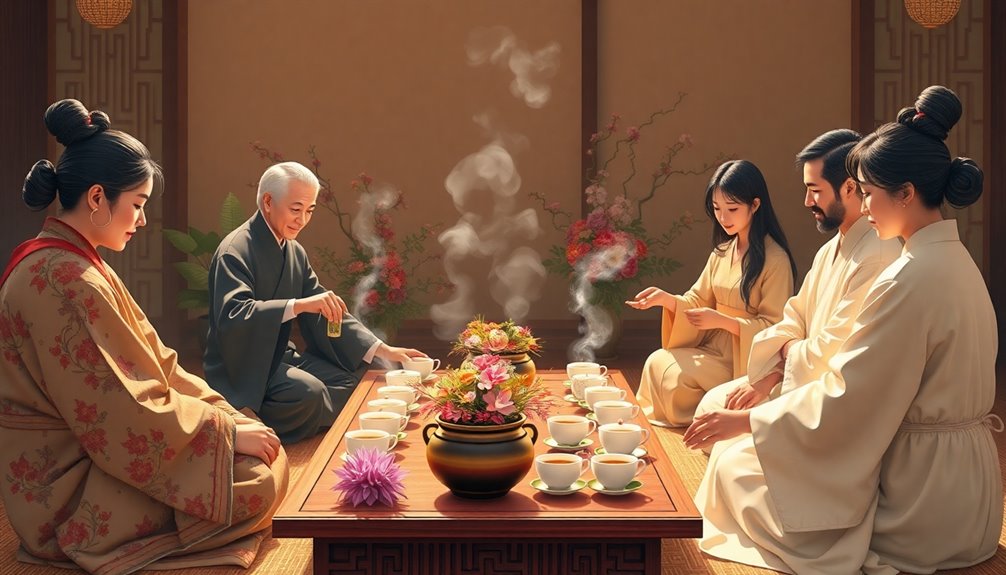
Tea plays a significant role in conflict resolution by creating a calm and inviting atmosphere that encourages open dialogue. When you share tea with someone, it's not just a drink; it's a gesture of hospitality.
In cultures like Japan and China, this act fosters respect and helps ease tensions, making it easier to build trust.
In many Middle Eastern cultures, serving tea is a traditional part of peace talks. It shows a willingness to engage in reconciliation and dialogue.
Research shows that communal tea-drinking rituals create a strong sense of community and belonging. This bonding can be crucial in resolving conflicts, especially within neighborhoods or groups.
Even historical events, like the negotiations during the Treaty of Versailles, used tea gatherings as informal settings to ease tension.
When people sit down together over a cup of tea, they're more likely to listen and understand each other.
Cultural Appropriation in Tea Practices
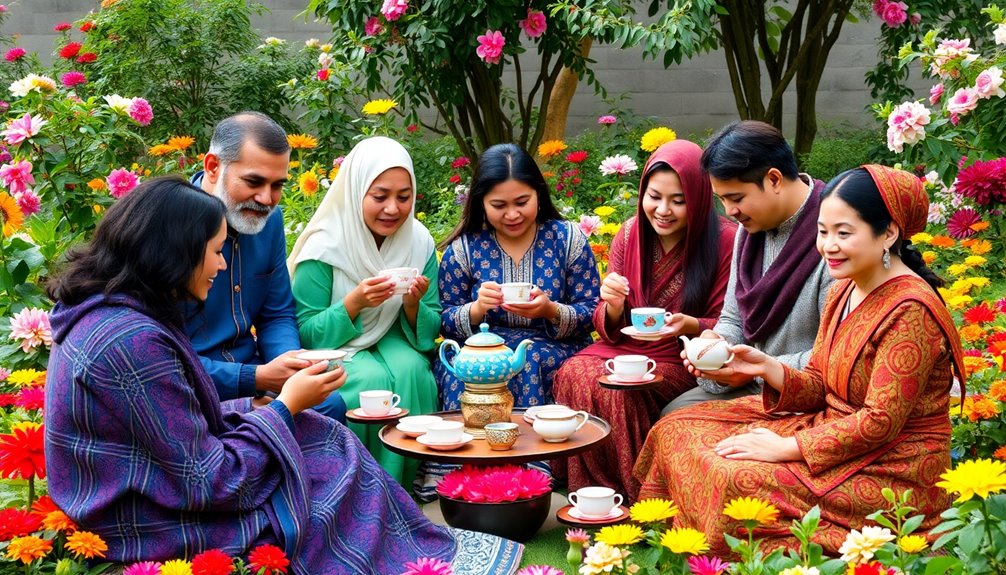
Many people enjoy exploring tea traditions from around the world, but this curiosity can sometimes lead to cultural appropriation. When you adopt elements from traditional tea practices, like the Japanese tea ceremony or Chinese tea culture, it's essential to understand their historical significance. Additionally, being aware of cultural sensitivity can enhance your appreciation of these practices. For example, understanding the ideal steeping time for different teas can deepen your connection to their traditional preparation methods.
If you enjoy chai, remember it's more than just a tasty drink; it's a social ritual deeply rooted in Indian culture.
Today, you might notice bubble tea gaining popularity, but it's important to recognize how this trend can commodify Taiwanese tea culture. Mixing chai spices with Western styles in cafes sounds fun, but it can dilute cultural heritage and misrepresent traditional practices.
When engaging with diverse tea traditions, keep mutual respect at the forefront. Take time to learn about the roots and rituals associated with each culture. Respecting these customs not only enhances your understanding but also strengthens the social bonding that tea promotes. Additionally, recognizing the impact of globalization on local traditions can help in understanding cultural exchanges and their complexities.
Practical Applications
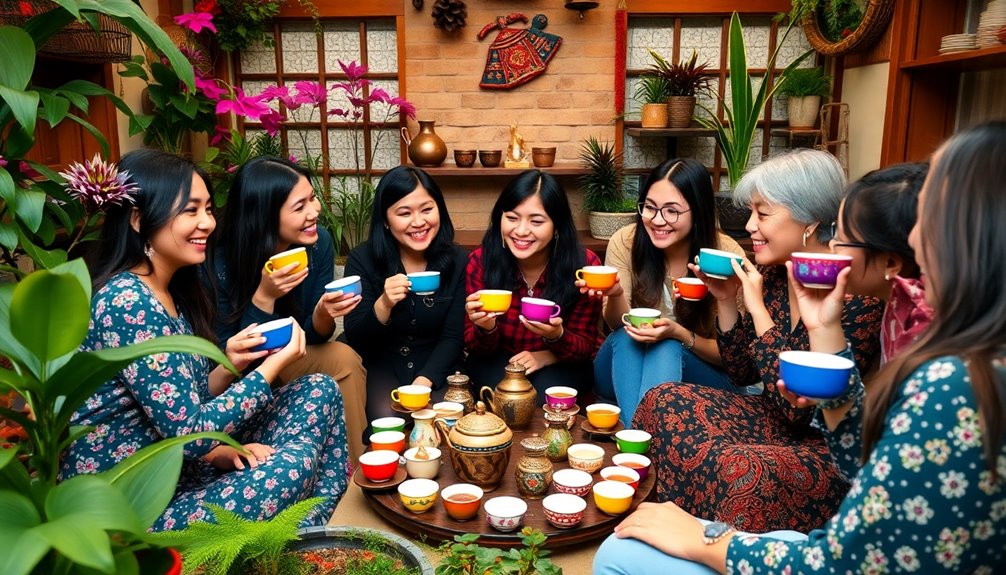
Exploring the rich traditions of tea can open doors to deeper connections and shared experiences.
Tea is an integral part of daily life in many cultures, serving as a bridge that brings people together. In Japan, tea ceremonies focus on respect and mindfulness, while in the UK, afternoon tea acts as a daily anchor for friends and family to strengthen social bonds.
Tea shops and houses, like those found in Morocco and Turkey, are social hubs where folks gather to chat and foster connections across diverse backgrounds. Whether you're sipping black tea or enjoying a modern chai at a café, these moments create a sense of belonging.
You can also host tea gatherings at home, inviting friends to share their stories over a warm cup. These gatherings can range from intimate family moments to larger community events, allowing everyone to feel included.
Even in our digital age, virtual tea parties are becoming popular, bridging distances and allowing connections to flourish. Additionally, sharing different tea types can enhance the experience, as various flavors and health benefits stimulate conversation and bonding.
Frequently Asked Questions
What Is the Cultural Significance of Tea?
Tea's cultural significance lies in its ability to bring people together, create rituals, and symbolize hospitality. Whether in ceremonies or casual gatherings, you'll find it fosters connections and shared experiences, enriching lives across various cultures.
How Does Tea Connect People?
Tea connects you by creating shared experiences, inviting open conversations, and fostering a sense of belonging. Whether in a cozy home or a bustling tea house, you'll find connections that transcend differences and build relationships.
In What Ways Does the Tea Ceremony Represent the Attitudes of Its Culture?
You'll notice that the tea ceremony reflects cultural attitudes through its rituals, emphasizing mindfulness, respect, and community. Each practice showcases values like harmony, hospitality, and connection, making the ceremony a meaningful expression of cultural identity.
Why Is Tea an Important Part of the Culture and Everyday Life of Japanese People?
Tea's an essential part of Japanese culture, enriching daily life with rituals that promote mindfulness and harmony. It creates moments of connection, allowing you to appreciate beauty and tradition while fostering respect and community among participants.
Conclusion
In conclusion, tea isn't just a drink; it's a bridge that connects people around the world. Whether you're sharing a cup during a celebration or using it to mend differences, tea plays a vital role in bringing us together. So, next time you enjoy a warm cup of tea, think about how it can strengthen your friendships and create new bonds. Embrace the traditions and make your own special tea moments with family and friends!

